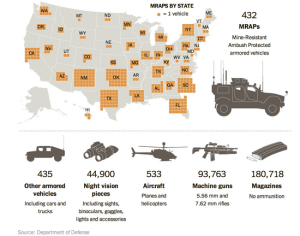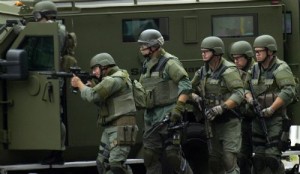The Obama administration is reclaiming the military equipment that the Federal government gave to police departments. In May 2015
President Barack Obama announced a new executive order aimed at making sure that situation — more often associated with Palestine or Cairo’s Tahrir Square than America’s heartland — doesn’t happen again. Speaking in Camden, New Jersey, the president banned the Pentagon from issuing some surplus military hardware — including rifles, grenade launchers and armored vehicles — to police departments nationwide.
This is being carried out:
Many law enforcement agencies around the country, including in Michigan, have hand-me-down military equipment.
Now, the federal government wants some of it back.
Muskegon County Sheriff Dean Roesler says most of the discarded military equipment the county once owned was given to other police departments in the state. That was done because Muskegon County’s Emergency Response Team disbanded in March.
Under the President’s executive order, police agencies have until April 1 to return bayonets, grenade launchers, camouflage uniforms, and large-caliber weapons. Most departments in the state didn’t get that equipment.
What they do have in some places are armored vehicles that move on tracks. The government wants those back, too.
“It is just not practicale on surface streets,” said Sheriff Roesler, adding that the one Muskegon owned was returned this week. “We were planning to return it anyway, because we just were not using it.”
Obama’s executive order does allow police departments to keep ex-military vehicles that move on wheels.
“It does not impact us directly; however, I do disagree with the order,” the sheriff said.
Several law enforcement agencies in Michigan are returning similar armored vehicles. Roesler says the vehicle’s weapons were removed, so they were mostly used to protect SWAT and emergency response teams.
“This perception that police are using them to create a hostile environment for our citizens is totally false,” the sheriff said. While this one Muskegon County once owned was seldom used, it could have been used in a hostage situation “to try and mitigate a hostile event and to provide officer safety and citizen and officer rescue if necessary.”
Roesler, like so many in law enforcement, said he hopes they never have to use their heavy equipment, and now he has less of it to use if there ever is a need.
The equipment that’s being turned over may eventually be used by the Department of Defense as targets at military training ranges.
In San Bernardino the SWAT team was going through an active shooter drill minutes away from the terrorist attack and was able to be on the scene within four minutes. They used their military equipment.
On the day of the mass shooting in San Bernardino, Calif., the city’s SWAT team was training for an active shooter situation just minutes away from the scene of the massacre.
“We were just working through scenarios when this call went out,” says Lt. Travis
Walker says they’d decided to train on Wednesday in part to learn some lessons from the deadly shooting in Colorado Springs, Colo., last week. This response isn’t unique to San Bernardino; in the weeks since the terrorist attacks in Paris, local law enforcement agencies around the country have been preparing for the possibility of more challenging attacks. In San Bernardino on Wednesday morning, Walker was running his officers through scenarios with volunteers playing the role of shooters.
“We’d just finished a training scenario that involved multiple shooters at multiple locations within a small confined area,” he says.
The Obama administration is unhappy that the San Bernardino attack may undermine its efforts to demilitarize the police:
Most policing experts agree this kind of gear is needed, but some of the more reform-minded experts are also apprehensive. They’re watching for the fallout from attacks like this.
“What went through my mind was the fear that people were going to jump to the conclusion that, oh, my gosh, we have to go back to just being warriors,” says Sue Rahr, who runs the police academy in Washington state. Rahr was part of President Obama’s Task Force on 21st Century Policing, where she argued strongly for police to think of themselves less as warriors and more as “guardians.”
“Frankly, the most important thing we can do is figure out ways to prevent or predict when these are going to happen so we can stop them before they happen,” she says, “because there’s no way — with the best training and equipment in the world, we [only] have about two or three minutes before the worst of it is usually over.
The United States, unlike most countries, prohibits the use of the armed forces within the country. But there are occasions, such as riots and terrorist attacks, when ordinary police equipment is inadequate. Obama thinks that militarized police are a bigger danger than rioters or terrorists; he may even be right, in terms of casualties, but most Americans fear criminals and terrorists more than they do the police, even if the police over-react. Most Americans: but not the Obama administration and many of its supporters.
PS: this is not a simple left-right matter. Many libertarians do not like a militarized police, but most of the criticism of the police comes from the left, which sees terrorism as a distraction from real problems like climate change and does not want to see its constituency arrested, convicted of felonies, and stripped of the vote.

